[We’ve teamed up with korev – a refreshing lager, born in Cornwall, with a deep heritage in surfing – to bring you a brand new series here on Wavelengthmag.com. Over the next few months, we’ll be heading to some of the South West’s most iconic surf towns and sitting down at the local with a few legends of the scene for a chat about the history, the culture and the characters over a couple of cold pints of korev.]
Cut into the westernmost coast of the British mainland – just to the north of Land’s End – sits the sweeping Sennen Cove.
Among surfers, it’s a beach equally regarded for its thumping winter waves as it is for its long, log friendly peelers. The sort of place you’d go on small summer swells and on a hopeful punt when other beachies were maxing out. This diversity has seen the cove assume a significant role both fostering some of Britain’s best heavy wave talent and spawning a crew of traditional loggers of global repute.
A scattering of loose boulders descended from the vast granite cliffs trap the quickly moving sand, moulding it occasionally into fleeting but beautifully defined banks, which, if you’re really lucky, might stick around for a month, but more usually won’t last the week – torn apart by the abundant rips or a bout of wild weather trampling in off the Atlantic.
Unlike the ever-changing nature of the lineup, the land that overlooks it has been left largely undeveloped by Cornish coastal standards, particularly as the cove bends around to the north, where it becomes Gwynver – a privately managed beach, accessed only by a steep climb down the cliffs. These factors, combined with its geographic remoteness and the weather-beaten scenery lend a uniquely rugged feeling to the cove and the surf scene that has developed here.
It would be impossible to chronicle this evolution without starting with Skewjack Surf Villiage – a nascent surf holiday camp, founded in 1971 on a disused RAF base just outside the town. Throughout the decade it grew to become a focal point of the local scene, renowned for welcoming hordes of excitable youngsters and for hosting many great parties, thoroughly enjoyed by them and the locals it employed.
Around the table this time to help us plot the course are; local chargers Harry and Jack Hoare, who grew up on the beach at Gwynver and have worked as lifeguards there for all their adult lives. Their dad Harvey – a surf instructor at Skewjack and one of the cove’s top surfers in the late ‘70s and ‘80s – who joined us down the line from Mayorca where he was escaping the bite of the British winter. Sam Bleakley, multiple European Longboard Champion, author, filmmaker, geographer, university lecturer and all-around scholar of the local scene. And, finally Mike Lay, also a professional longboarder of high acclaim, plus a local lifeguard, writer and poet, whose work has appeared frequently in this publication and many others.
Our host was the charming Old Success Inn, perfectly positioned at the southern end of the cove with an elevated decking looking out over the lineup, complete with lights and heaters, making it the perfect spot for a winter pint. With several korevs pulled (and going down swiftly,) we decided to dive in at the very beginning.
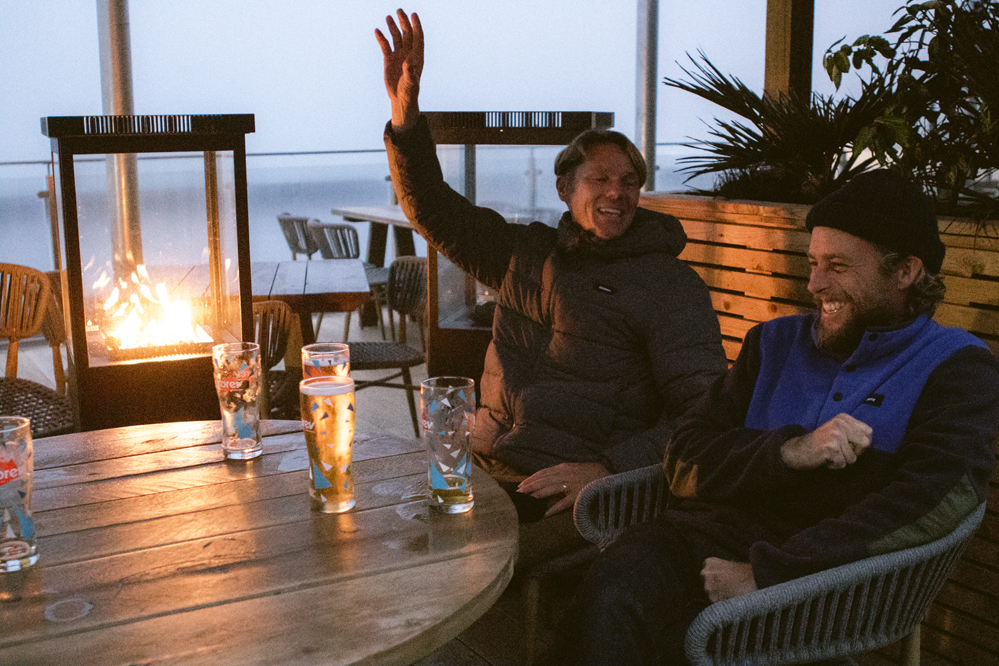
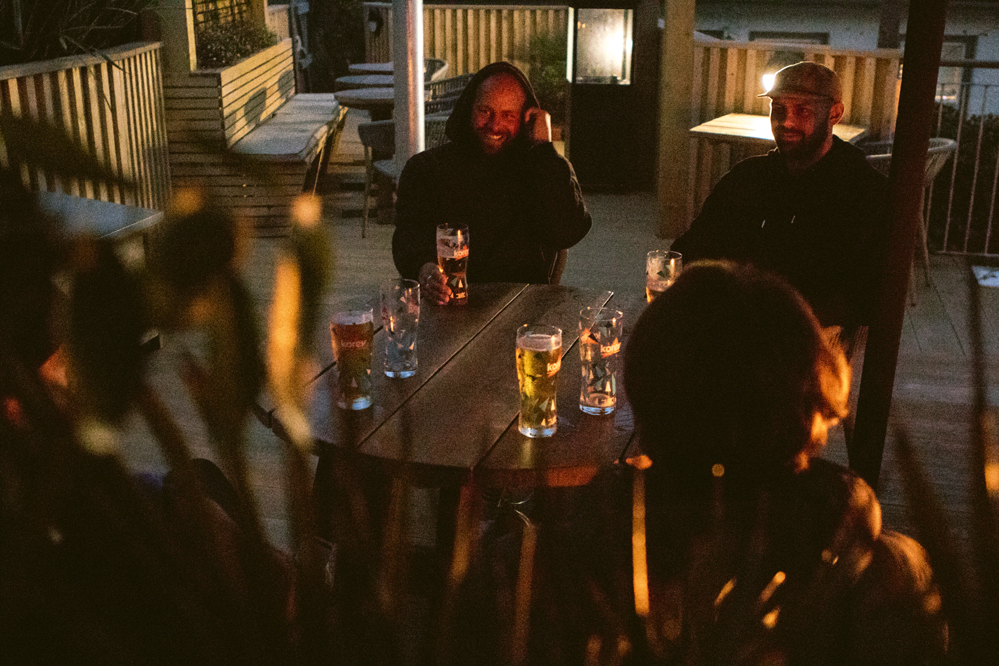
(1) Sam Bleakley and Mike Lay. (2) Harry and Jack Hoare.
SB: When did you start surfing Harvey?
Harvey: I started in 1973. The English contest was held at Gwynver, which I went down and watched. I think Graham Nile won it, Charles Williams was second, Tigger Newling was third.
[Ed. that’s some of Britain’s earliest and most seminal surfer/ shapers. Graham from St Austell, Charles from St Ives (who features heavily in our round table conversation from there) and Chris ‘Tigger’ Newling from Treyarnon]
Harvey: It was the first time I’d been and watched surfing and the prize-giving that night was at Skewjack. About a month later Mike (Carr) and Jo Crow persuaded me to give it a go. My first ever surf was at Sennen, in front of the cafe on a 6’10 single fin that I borrowed.
SB: How did you come to start working for Skewjack?
Harvey: I was working full time for BT and I used to take my whole year’s annual leave –which was four weeks – in August and have a month at Skewjack… working… ish. If you know what I mean.
SB: What made that time special?
Harvey: The friendships I built really, but surf wise, we had the waves to ourselves. You could go to Sennen or Gwnevor when it was really good and it might be a bit crowded if there were 6 people in.


The original Skewjack Surf Villiage brochure. Image shared by Skewjack Stories, by permission of Suki Bishop. When the waves were flat, Skewjack offered plenty of other activities to keep punters entertained. Image shared by Skewjack Stories by permission of Chris South.
LG: Is there a particular summer from when you were working at Skewjack that stands out?
Harvey: ‘76 and ‘77 were probably the best two years.
LG: What do you remember from those times?
Harvey: It’s more what I don’t remember! Skewjack had just been on the BBC’s Holiday programme, so in ‘76 and ‘77 it was full! They basically had to turn people away so they could allow more girls in, because it was all guys that wanted to come down and Chris Tyler [the owner] would say, ‘if we have too many guys and too few girls it causes trouble.’ They actually had enough applications in those two years to get it to a 50/50 ratio. People came down to give surfing a go and to party and for most who went there, it was their first holiday away from their parents. They used to go berserk basically! We had to put in a little bit of effort to teach them because we were getting paid. But we only gave the punters… I mean the clientele at Skewjack… we only gave them shorty wetsuits, so they didn’t stay in that long. They’d be in for half an hour, freezing cold, then they’d get out and we could go in and surf!
JH: Tell us about when the surf was good at Levvy, but you had all the Skewjack punters with you… did you ever take them there to watch you and ‘show them how to surf’?
Harvey: Nooo, [all laughing] not officially. I didn’t take them to watch me. I’d take them and say, have a look at Porthleven… while I had a surf.
SB: I know someone you were always close to and who I always looked up to was ‘Jmo’ – Steve Jamieson, who was one of the early lifeguards. What was his role in the development of the scene?
Harvey: Well, back then, what’s now the lifeguard hut at Gwynver belonged to a couple, it was their little beach hut, and in ’77 the council rented it off them. Mike Cattran was the first lifeguard and he did it on his own the first year and then the second year Steve Jamieson joined him.
I’d known Mike for many years through surfing. But with Steve, because he didn’t surf that well, ours was more of a friendship around the lifeguard hut. I used to go down to Gwynver when nobody else would. It would be a rainy day and onshore and I’d go in for a surf and end up sitting in the hut having a cup of tea with him and the friendship just built and built.
SB: Yeh I always wondered why there was always a BT van at the top of the Gwynver hill! My biggest ambition when I was young was to be part of the scene around the hut – with you and Jmo and Janus [Howard] – I thought you’d made it in life if you could hang out there with you guys.
Harvey: When Mike [Cattran] was my age, it was very special to get in there, because he was quite protective. He didn’t like anybody else coming to his beach surfing. Do you remember the days when you had to register your board with Penwith District Council?
SB: Yeh, I remember getting told off by people for not having the sticker on.

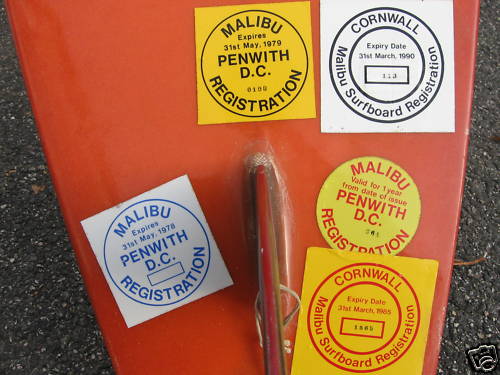
(1) The Sennen Lifeguards. Image shared by Skewjack Stories by permission of Barbara Freshwater. (2) A board adorned with council registration stickers. Sourced via vintagesurfboardcollectoruk.blogspot.com
Harvey: Well Mike could spot an unregistered board from the doorway of the hut as it was coming down the other side of the hill where the steps are now. He’d say ‘Jmo – go and get him.’ And the registration money would go into a little tin. And we’d say ‘whose round is it at the First and Last? Oh, I think it’s Reg-ee’s.’ So we’d open the tin and buy the beers!
[All laugh]
LG: You mentioned you learned to surf on a 6’10 single fin. How did what people were riding change throughout your early surfing years?
Harvey: Everybody was switching to shortboards by the time I started and even single fins were on the way out. But there were two guys at Sennen – Duncan Macintosh and Nigel Higginbottom – ‘Higgs’ – who carried on longboarding and they were the only two for many years.
SB: Duncan and his brother Robbie were amongst the first group to surf Gwynver in the mid-70s. He shortboarded for a long time but started longboarding again quite early in the late ‘80s.
LG: Were they a big influence on you when you chose to ride a longboard growing up Sam?
SB: Yeh absolutely. I started surfing in ‘82, and I was just shortboarding. We used to surf at Sennen, Gwynver, Perranuthnoe or Porthmeor, and my heroes were Essex and Cassius Tyler. And everybody knew how good Colin [Wilson] and Harvey were, the generation above, although Harvey had this injury at the time. You had others who were good, but for me they were the smoothest, the coolest, they were flashy. And then the crew that got quite handy, was me, Tristan Jenkins, John Buchorski and then Sam Smart. We really pushed each other. But yeh, I was definitely influenced by Duncan and Nigel and by my dad, who had learnt to surf in the ‘60s.
JH: The story of how your dad got his first board is one of the better ones I’ve heard…
LG: Tell it!


(1) The view from the Gwynver lifeguard hut. (2) A young Sam Bleakley styling on the nose. Photos: Greg Martin.
SB: My dad’s parents had planned to come down to Newquay to buy a guest house after the war. They went into partnership with a mate and put everything into it. Back then it was about £1000 for a little guest house on Headland road. Before the sale went through, their mate pulled out – but he gave my dad his two Burnley whippets to race at St Austell track to try and cover his half. My dad took them and put his £500 on them and they won! So the guest house was theirs. My grandad was as Glaswegian as they come. He was a heavy drinker and had a trawler out the harbour as well as running the guest house. He used to keep the bar open for the Aussie lifeguards to drink in after work and they would stay late and play poker. One of them ended up owing Jock, my grandad, a lot of money and he paid it to him in a surfboard, which Jock gave to my dad for his birthday. After that, my dad started getting in with his friend Ian ‘Porky’ Morcom, who had a beaver tail divers top, in February! And they used to take turns with the board and the beavertail, wearing a woolen jumper underneath. My dad eventually became a shortboarder, like everyone did in the late ‘60s, but he loved surf nostalgia. He had a mate, Paul Holmes, who he grew up with and they started Surf Insight magazine in the ‘70s and Paul went on to edit Tracks and then Surfer. So we were quite plugged into the surfing world and in the early ‘90s, we could see that longboarding was taking off again elsewhere, so me and dad got some boards off Chris Jones in Newquay and started getting into it. All of my mates at school were like ‘what are you doing man? That’s an old man’s sport.’ This was just after Momentum came out, with Slater and Dorian and all these new light-footed surfers. I would surf with Tristan and John Buchorski, and they were ripping and I was the lone young longboarder. Everyone thought I was crazy and would tease me. I used to work here, at the pub, and the travelling Aussie chefs would say ‘Bleakers, you’re going to get nailed on that thing if you go out later.’ And I’d see them when I was knee paddling out and just shout ‘yew boys!’ I just loved it. After I started winning a few contests and getting a few free things then eventually everyone was like ‘fair enough.’
There were a few other youngsters from elsewhere in Devon and Cornwall who came in it at the same time as me. Guys like Jim Newitt, Ricky Kenyon, Lee Ryan. Then there was Elliot Dudley and Ben Skinner and then Mike was part of the next generation.
HH: You gave James Parry his first longboard as well didn’t you?
SB: Pazza! Yes! It was great when these boys came through. [To Jack and Harry] I remember you on the beach, like the Hawaiian family, always so tanned. We were always trying to get a bit of Californian culture in, and with Harvey and your sister Daniella, you just had this really lovely vibe.
JH: So, this is probably going to slightly embarrass Sam and ourselves as well, but when the surf was small both of us wanted to be Sam…
HH: [To Sam] We had that old board from you…
JH: Yeh, or we’d knick one out of the lifeguard hut and just go out and pretend we were Sam. When it got a bigger, we’d all go out on our shortboards and pretend we were John Buchorski.
HH: Or Janus. You’d never see anyone surf Gwynver when it was over 6 foot apart from Janus.
SB: He’d done his time at Mundaka and the Canary Islands. He was one of the ones I would look up to when I was growing up.
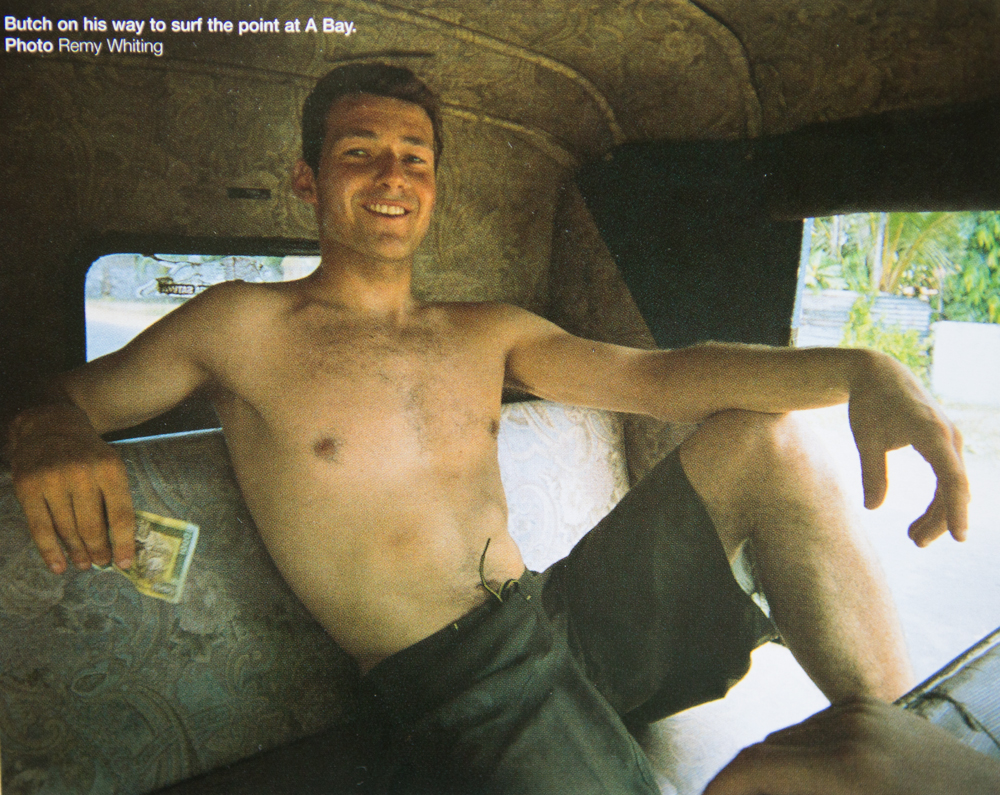
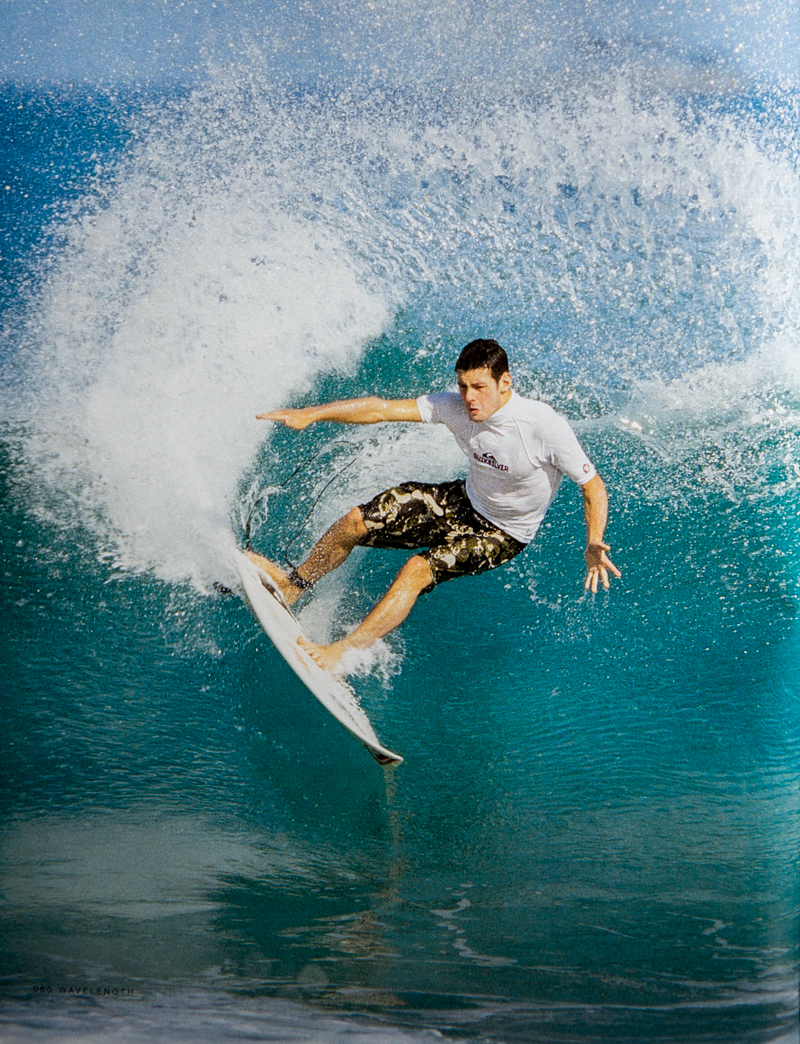
John Buchorski, from a profile in WL Issue 133. Photos: Remy Whiting & Pete Ash.
LG: Lets’ talk a bit about John Buchorski. I think despite his talent, he’s still got a bit of an underground status. Why is that?
SB: He was the same age group as Stokesy and Egor, and he was right there. He was a Quiksilver rider, he used to do the training camps. He came from a harder family. His dad died when he was young and then his stepfather died too and that was really hard on him. He had a lovely mum and two great sisters. But his situation was different to mine – I had a solid family behind me, who weren’t pushy but they were always there for me and John was much more out there on his own. He got sponsorships and he got money, but he wasn’t as able to harness it in the competitive scene. As a freesurfer though, everybody knew he was one of the best. He liked to go to Ireland and get away from it all. He was low key and shy and quiet.
JH: His style was unreal. It is unreal.
HH: He’s still as relevant as ever now as well, but he doesn’t surf that often.
ML: Yeh, he’s still as elusive as ever. You sometimes see him out on his own in the middle of winter. And every time you spot him there’s an intake of breath and you’re like ‘who is that?’ And then you realise it’s John. He’s the best surfer in the water whenever he’s surfing.
JH: Seb Smart will always tell me this story, of how one day he was walking down the steps at Gwynver, and it was really big and he spotted someone out on the point by himself. There were a load of international pros in Cornwall for an event and he thought one of them had found their way down to Gwynver. Seb was like, ‘I don’t know who that is, but they are definitely on the world tour.’ I think John hadn’t surfed for a year or so, and hadn’t been around the scene much for various reasons, but he’d paddled out and it was him. Seb said that is the best surfer he’s ever seen down here, by a mile. And Seb’s not one to big people up.
SB: In my generation, there was also a lot of boogie boarders who deserve a mention. Steph Skajarowski, Mickey Smith, Dave Spencely, Juan Roseigh, Martin Oaks. Piran and Dan [Skajarowski] after Steph. And Jack [Johns]. They went and scoped out all the reefs around here and then they started going to the Canaries and Ireland and Australia and Tahiti. And those guys were so important for West Penwith surf culture. This is where they cut their teeth. They literally did the whole coast; there won’t be a generation that have surfed more of the nooks and crannies in Cornwall than they did. That was a really cool time, when you had a few people getting into longboarding, the core bodyboard crew and the shortboarders. It was before everybody splintered off to specialise – you know now you see the bodyboarders only on the slabby days and the longboarders ride the small days. But that was quite a special time with everyone surfing together.
LG: It’s amazing that this cove is famous for both. You know, Jack, the Skaj brothers and Mickey are probably some of the hardest chargers ever to emerge from Britain, so it’s strange that it’s produced that and then longboarders who are specialists in smaller, cruisey stuff. How’s it managed to birth those two seemingly disparate groups?
ML: I think there’s something about the geography of the cove here, from where we are at the south end of Sennen, to the point at Gwynver, there’s a real variety of waves you can choose to surf. Here can be really longboard friendly on the biggest days, and then at Gwynver, when the sand is right you can get some really heavy bodyboard friendly waves. I just think there’s a real diversity of surf in this really small area.
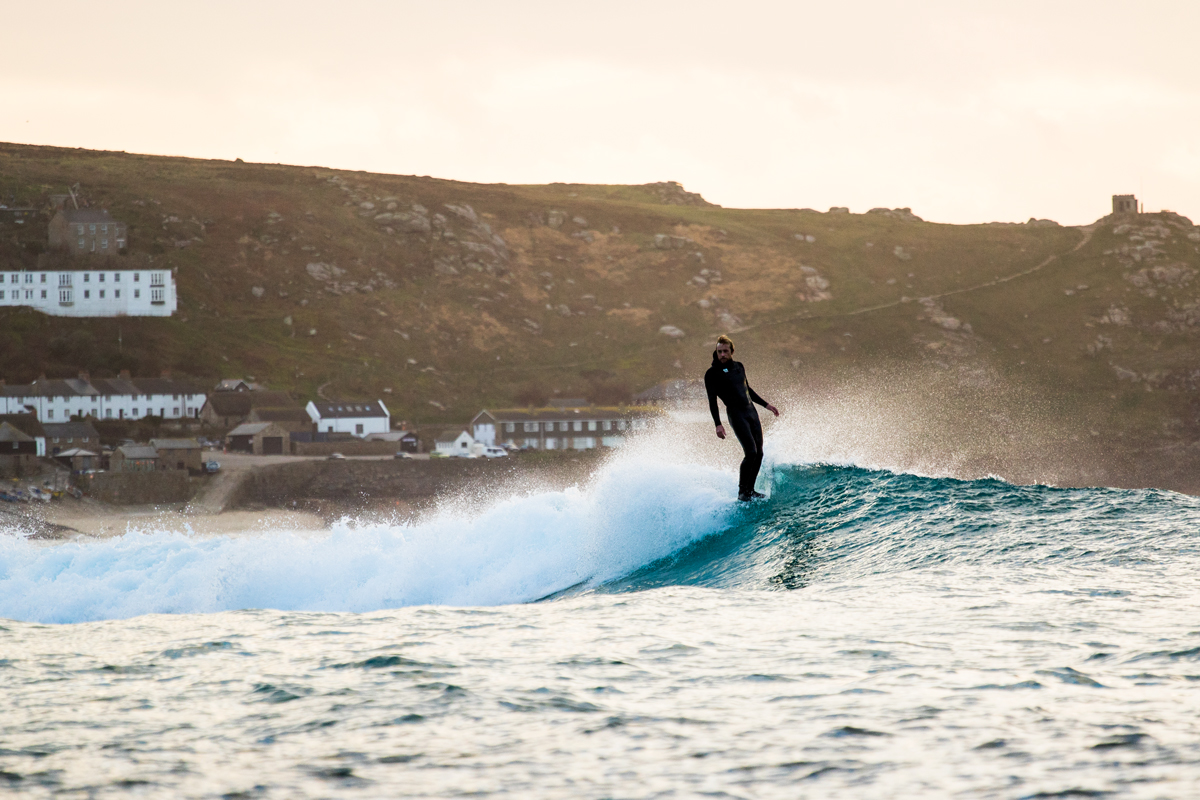
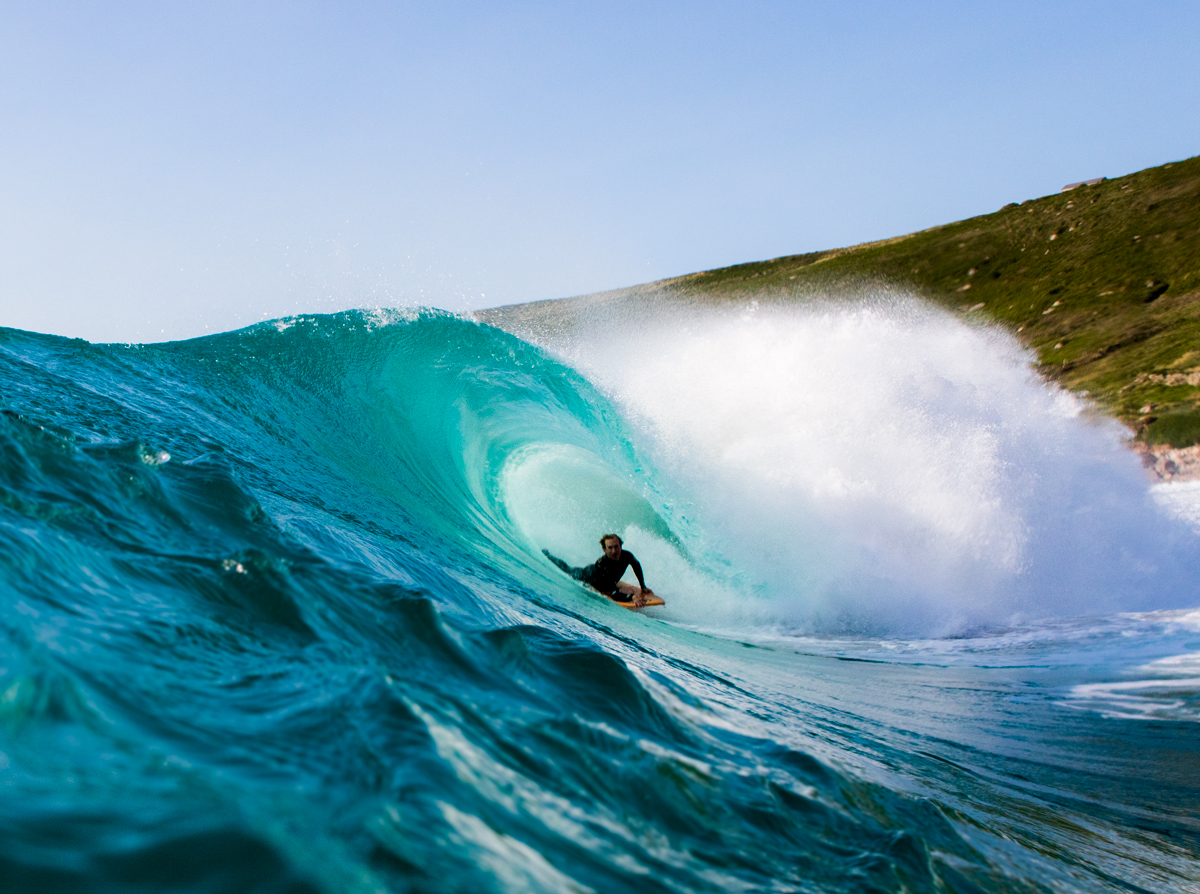
(1) Mike on the nose on a small peely day. (2) An unknown bodyboarder searching for an inside cover up. Photos: Luke Gartside
LG: Mike, tell us a bit about your entry into surfing?
ML: It’s interesting to hear everyone talk about their upbringing, because my family didn’t surf, so I don’t have the same connections to the place through generations past. And I only started surfing when I was 12. I went swimming with Jack and Harry, and I’d hear Lisa their mum talk about how they were doing well in comps already; I think Jack got the quarters of the Grom Search, and I was like Woah! The quarter-finals!
JH: It was the semis actually (laughing)
LG: It’s lucky you’re here mate that would have gone on the record all wrong.
ML: Ha! I just remember hearing that at the swimming club at Penzance leisure centre, and thinking that is so sick. I started riding Swell boards at the Sennen surf club and I remember the standard graduation process; you’d get a green wave on a Swell board, and then it was time for you to get your shortboard. I remember getting my first shortboard and not being able to catch waves like I could on my Swell board. Then I’d see Sam and James Parry riding their longboards and also Dave Shephard, Graham’s son, told me I should ride a longboard. I remember really enjoying it and getting loads of waves on that. Mick Jackson was also really supportive.
SB: I remember Mick saying to me once, ‘there’s this guy called Mike and he’s getting really good, what do you suggest?’ And I said he should learn how to ride some more boards because I think that’ll really help. Because it’s strange, but once you get to a certain level on a longboard, you need to learn how to shortboard to keep progressing.
ML: I remember you telling me that too. It was when Tyler Hatzikian came down, with Belinda Baggs and Dane Peterson, and you said you should keep riding shortboards as much as possible. And I remember as a kid going, ‘I don’t know man, I think I’ll just longboard cheers mate.’ But that stuck with me through my whole career, and now I think it was one of the most important pieces of advice I’ve ever been given.
LG: So it wasn’t like that ‘ride everything’ ethos came to you from California via a film, it was just something that you worked out because it was helpful for your longboarding?
SB: I think if you’re already comfortable using that much equipment, then it’s really natural to get comfortable using everything else in between. Longboards, mid-lengths, fishes, eggs.
ML: And you know the conditions are not longboard friendly all the time, so you naturally gravitate towards other equipment.
SB: Yeh, or if you were doing a trip and you needed a board you could ride a heavier wave on, it was just common sense. And then you’d think about tail shapes and weights and widths and fins. And then all that stuff took off fashion-wise. But I got into riding a lot of different boards because it’s functional.
ML: I was also influenced by [Thomas Campbell’s films] The Seedling and Sprout, as they came out a couple of years before I started. Myself and Matt Travis would watch them all the time. But also, the people in our surroundings, watching Sam and Pazza riding different boards. And Rich Emerson – he was an ever-present figure on the longboard and alternative board scene and he did good parties in St Just. Him and Pazza would go to Australia or California and come back with amazing boards.
SB: When Pazza came on the scene, it was wicked because he was such a skilled nose rider.
ML: He was doing airs on a shortboard and longboarding at the same time.
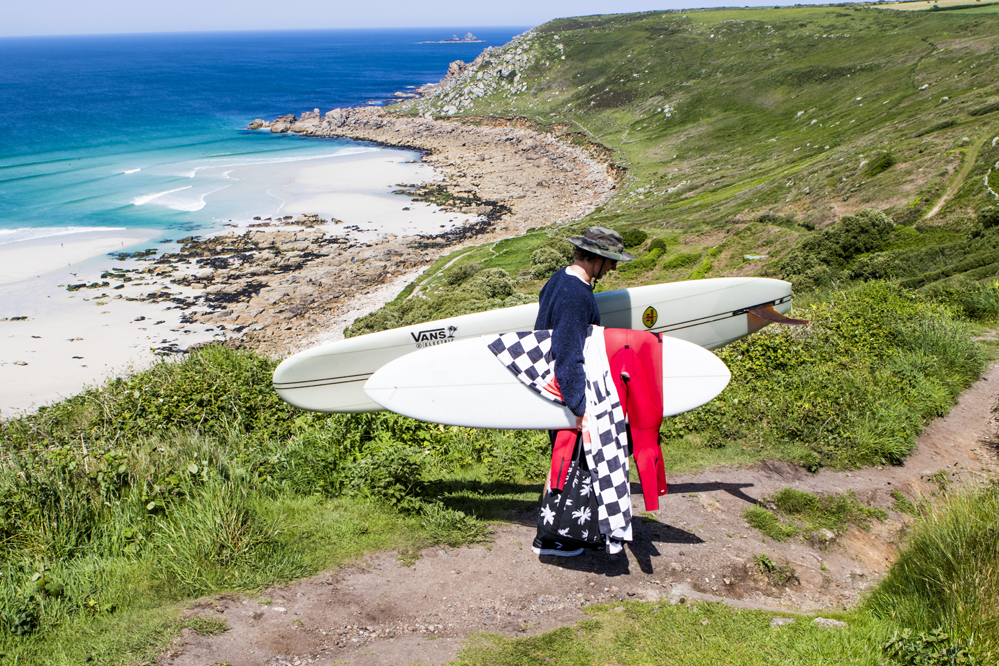

Multi-craft master James Parry cut his teeth in the cove, but recently jumped ship to the long spinning points of The Sunshine Coast. Photos: Luke Gartside
SB: The breakthrough year for Mike in my eyes was when he got the boards from Slide 65. They were nice boards, progressive, knifey.
JH: And you had a year working with me on the beach where I let you surf every day! Well, He was in charge, but he just told me, ‘Jack, I’m going surfing.’
ML: (Laughing) We were both super young, weren’t we. I was like 21 and you were 20 and we were working Gwynver with no one around and I just thought I’m going to surf for 6 hours a day.
SB: And there was a low tide left sand bar that was about 200m long… I mean you may as well have been on a training camp that summer. I think you both ran the beach brilliantly and you went from being a good logger to one of the best loggers in the world, all of a sudden.
JH: Meanwhile I just had new people coming to the hut every day to see Mike.
ML: Poor Jack had grown up at Gwynver hut and I’d just arrived there two years before, and I was like right mate. I’m going surfing!
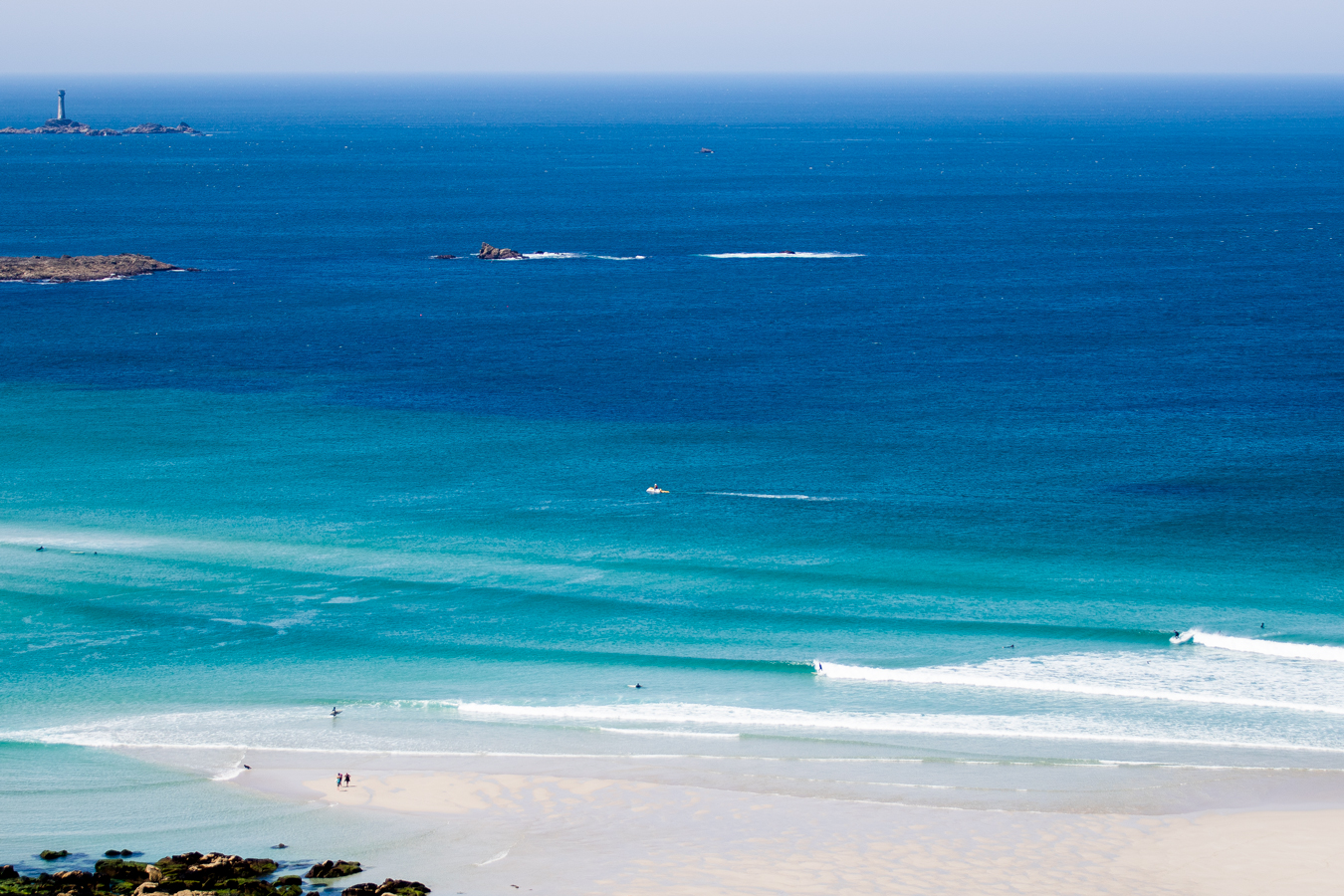
A reverse version of the long Sennen left that saw Mike’s surfing level leap. Photo: Luke Gartside
LG: What year was that?
ML: Nine years ago. 2011.
LG: I remember Nathan, former European team manager at Reef, telling me the story of how you got sponsored by them. He said he was just at the beach one day and saw you out surfing and said ‘I have to have that guy on the team.’ Was that the same summer?
ML: No, that was actually the following year, after I got tactically moved from Gwynver.
LG: Oh yeh, tell that story.
ML: We’d had a great year, Jack and I, running the beach, I thought we did it really well, I’m pleased to hear that Sam thought we did it well too. We took it really seriously. We worked really hard as well as surfing lots. It was the end of the season, I was the senior and… were you still there Jack?
JH: I’d gone, I was out with an injury.
ML: Oh yeh Jack had injured himself on the steps carrying water down…
[All laugh]
ML: As many lifeguards had injured themselves before. And it was a rainy day, the end of peak season, and I decided to have a celebratory roast dinner and eat it on the old decking, with a red and yellow flag that wasn’t being used as a table cloth and a bunch of flowers in the middle. We cooked a really lovely roast chicken. It was wicked, just the guards who had worked really hard. It was the early days of Instagram, when I had 14 followers. I took a picture of it and the bosses saw it and for whatever reason, it was decided that it was not quite a sackable offence, but close to. So I was offered the senior job at Porthcurno, or moving to Sennen and going back down to Grade 3. So I did that. And that’s when Nathan the guy from Reef saw me surfing.
LG: Were you just out at Sennen one day on a shift?
ML: I expect I was on a shift! That’s when I do most of my surfing [laughs]. A friend of ours, Russ Pierre, he came up to me on the beach and asked me if I was interested in being sponsored by either Reef or Vans. I was coming to the end of my university degree, and I was with my girlfriend, now wife, Frankie, and she’s a musician, so we were thinking of moving to London, so she could pursue her musical career and me maybe doing something in publishing. So when Russ said, ‘do you want to be sponsored?’ I was like ‘great, yeh.’ And then I forgot about it. Then a month later Nathan Hill, who was the manager at Reef for Europe, rang me out of the blue and offered me a sponsorship with £2000 a year, which was just mind-blowing for me. I thought it was just going to be some shoes! Obviously, we didn’t go to London in the end and it grew over a couple of years to me being invited to be part of their global team and I got offered a full-time wage to be a professional surfer, which even to this day… I don’t know, full imposter syndrome.
SB: In my day, it was winning a European title that got me recognised and got me on the deal with Oxbow. Longboarding has always had less than shortboarding, so there’s only ever been a handful of full-time pros. It’s great that we’ve created people who’ve had big sponsorships out of this little patch. I remember a time with Lew Smart, whose a really good bodyboarder, before he could drive I’d go and collect him from the chip shop [his family own] and we’d go to Newquay and win the English Championships – me on my longboard, him on his bodyboard – and then I’d drop him home again.
Then later Seb came on the scene. When Seb’s on form, for me he’s like the British Dane Reynolds, and this winter it was a pleasure to see him and Harry surfing big waves. The last two winters through the lockdowns, there’s been some really good things happening. Quiet but core people out having good surfs. I was really stoked to see some of that.
LG: Yeh, let’s talk a bit about that resurgent interest in surfing the really big days down here. [To Harry] We spoke in the Porthleven round table about that huge day when just you and Ryan surfed. Can you tell us about that?
HH: Well, Jack Johns had a board that had Futures boxes, and he said he needed me to come, because he needed some fins off me. I was like ok, fine. I brought them over and I gave them to him. And he said come on let’s get in. And I got changed into my wetsuit and he just walked back up the hill.
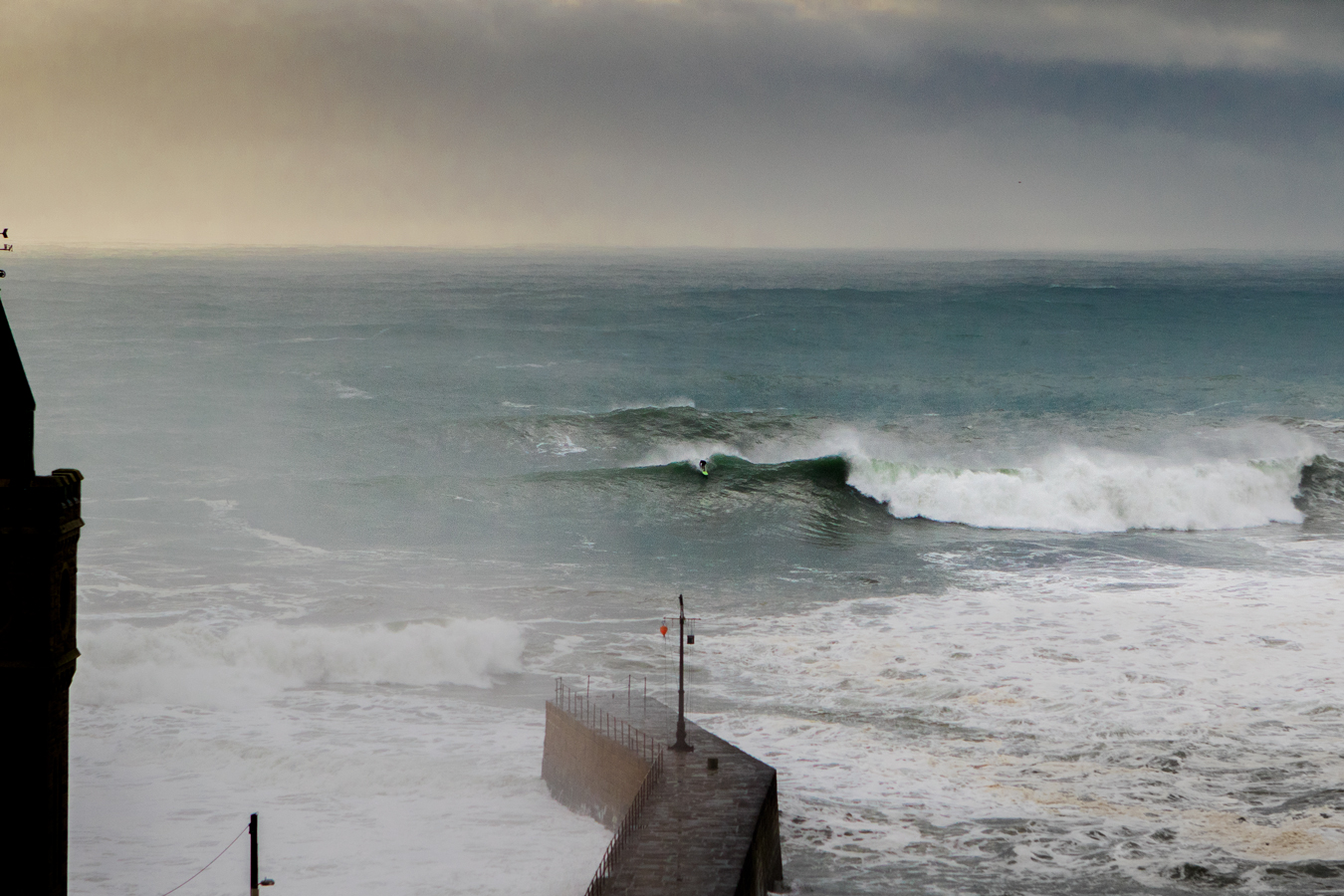
Harry takes off on a bomb outside the harbour entrance during a giant day at Porthleven last winter. Photo: Luke Gartside
JH: It jacked by about 10 feet in that time.
HH: I was like I’m not sure about this and then Ryan Holland turned up and was like come on let’s do it. He had a crazy hangover as well, he hadn’t drunk for a month or something until the night before. So me and him went out…
LG: That was wild. Were you there for the session where Seb got that mental shot…
HH: He rang me at about half 5 and told me he was going to surf Gwynver. I was at home and I said I won’t make it, it’s getting dark. He said I’m just going to finish dinner and go. I was looking outside thinking, it’s pretty much dark! He went down to the point with Nigel Aird and Nigel said it was just light enough to take a photo. He jumped in off the point and got that one, pretty much in the dark.
SB: I saw it from the top of the cliff and the photo doesn’t do it justice. It was like slow motion and the hold-down after was brutal. I was like that’s why we don’t go out there when it’s like that. Because there’s no reef and no deep water. But Seb was having a lot of really good sessions around that time. What was cool was in that first lockdown, where it was pumping for months, I’d see Mike walking over from St Just. I really loved that period, with just a few people sneaking in.
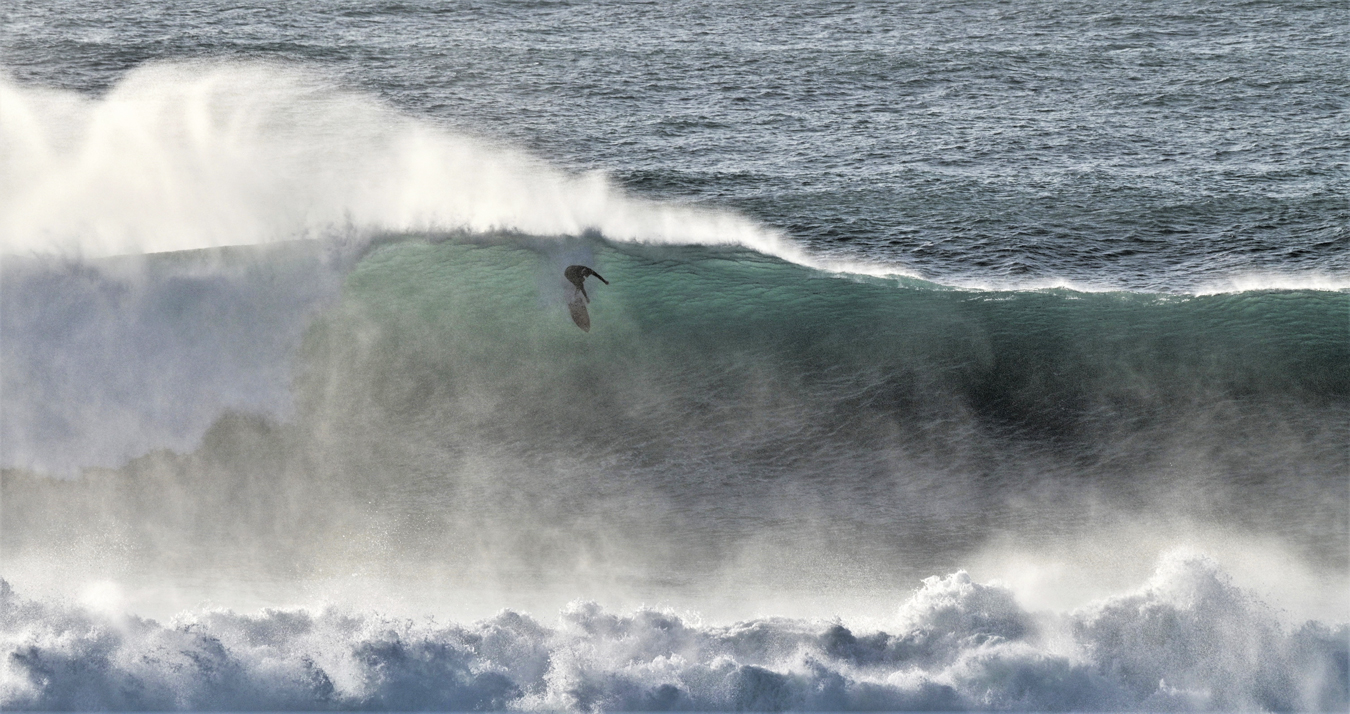
Seb Smart on what many are calling the biggest wave ever surfed at Gwynver. Photo Nigel Aird
HH: We’d get up at like 4 in the morning because time didn’t really matter and just park up down here and sit there for a few hours until it got light.
ML: Do you remember the full pink moon, and the banks were as good as I can remember in my whole life we were just surfing it for that few weeks, just me, harry and Pete [Geall]…
HH: And a couple of random bodyboarders you’ve never seen in your life!
SB: And the sessions that started to happen once the word got out and the world started to open up again, on the high tide bank. The number of amazing barrels!
ML: When the bodyboarders told all their friends on their bodyboard WhatsApp groups that they must have. (laughs)
SB: Through that whole period, there was a low tide right-hander that had such a reliable lineup with the right chimney of Sarah’s house. I had it so dialled. One day, just as it was getting all summery and busy, I got one, and it was a smoker and I thought ‘that’ll do.’ Jack [Johns] was just paddling out and I said ‘line up with that chimney and wait.’ And I got back to the beach, and I was watching and everyone was scrambling around and not much was happening. But he listened and he just stayed there, and then about 8 minutes later, a set came and he got this absolute grinder. That’s how good the banks were. You could actually lineup for the good ones – and that doesn’t often happen.
LG: Let’s talk about some of the young up-and-comers who deserve a mention.
SB: George Carpenter.
HH: And the New brothers. [Woody and Huck]
ML: Jake Sage is fucking amazing. Especially on the heavy days at Gwynver last year. He was a standout.
JH: When he’s going and the conditions are right, he’s phenomenal.
ML: Dylan Smith is a new underground kid. He’s a real longboarder and rides everything.
SB: I think between Sylvie [Puddyphatt], Lola [Bleakley – Sam’s daughter] and Izzy [Henshall – Sam’s niece] they’re going to have such a big impact on the scene. And they have all been inspired by Maise Marshall who is a super stylish local logger and was a British Champion.
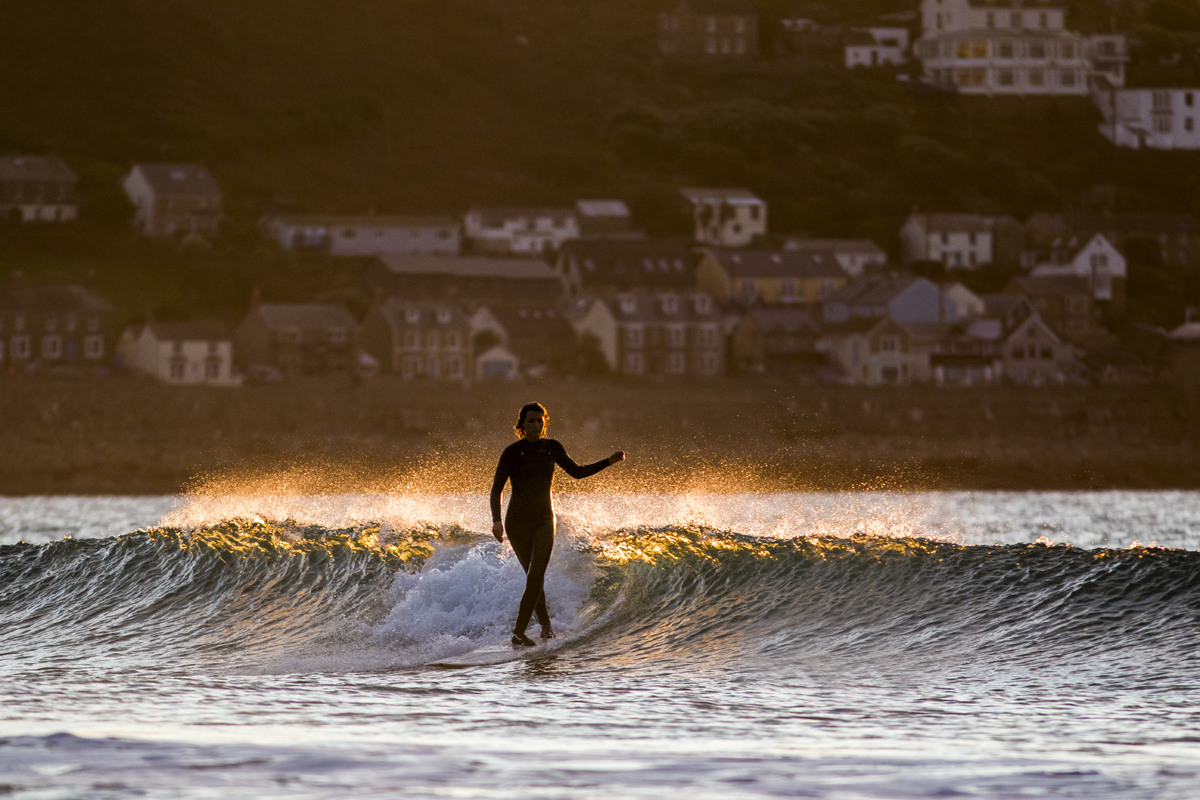
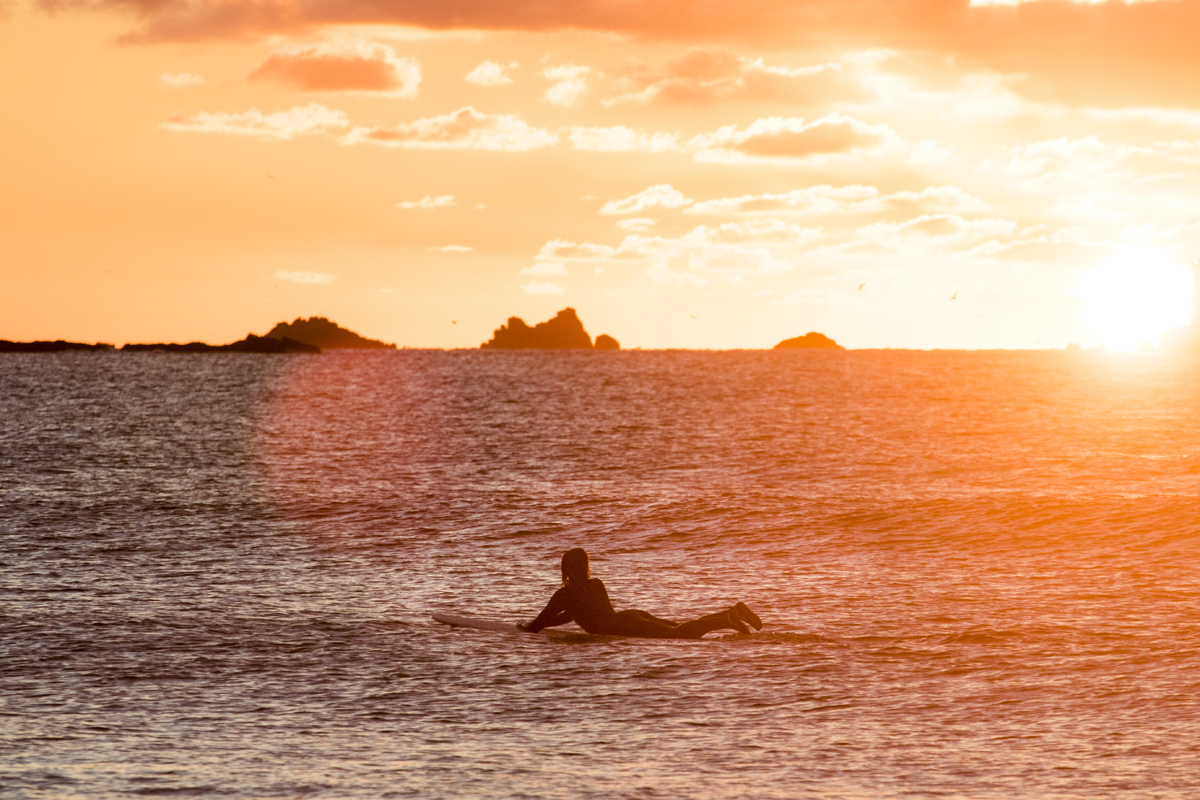
Izzy Henshall at home, photographed as part of a recent feature & short film. Read and watch here. Photos: Luke Gartside
ML: In this last year Izzy has just become the best British female longboarder that there is. She’s now at an international level – and those other two are going to join her.
HH: They have to, because they’re in the sea every minute of the day!
LG: It seems like the lifeguard hut has been a real constant focal point for local surfers throughout the development of the scene. Are the guys you’re mentioning likely to continue that legacy?
JH: That’s what we’re trying to do, lifeguard wise, we want to get local surfers back in there. I think all the stories we’ve told come about because we’re just a group of surfers who have grown up around here and want to look after the beach. We’ve sat there and watched them all since they were little groms and now we want them to come in and start lifeguarding. We know they know everything about the beach already.
SB: [to Jack and Harry] When you two boys run the beach, you do it better than anyone. You were born into it. You could walk down there, put the flags in with your eyes shut and they’d just be in the right place, because you just know the coast here.
LG: Thanks for the stories boys!
Cover photo: Luke Gartside
